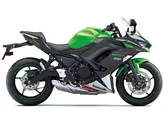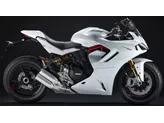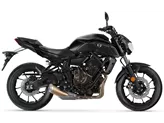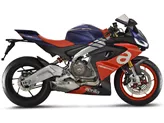Kawasaki Ninja 650 2020 vs. Ducati SuperSport 2017

Kawasaki Ninja 650 2020

Ducati SuperSport 2017
Overview - Kawasaki Ninja 650 2020 vs Ducati SuperSport 2017
The Kawasaki Ninja 650 2020 and the Ducati SuperSport 2017 are both sport bikes that offer a thrilling riding experience. However, there are several key differences between the two models.
In terms of engine specifications, the Ninja 650 is equipped with an inline twin engine with a displacement of 649cc, producing 68.2 horsepower and 65.7 Nm of torque. On the other hand, the SuperSport features a V-twin engine with a displacement of 937cc, delivering a more powerful 110 horsepower and 96.7 Nm of torque. The SuperSport's engine also has a higher compression ratio of 12.6, indicating a more efficient combustion process.
Both bikes have a similar suspension setup, with telescopic forks in the front and a monoshock in the rear. However, the SuperSport's front suspension has a larger diameter of 43mm compared to the Ninja 650's 41mm forks. The SuperSport also offers more adjustability in the rear suspension, with options for compression, preload, and rebound adjustments.

Kawasaki Ninja 650 2020
In terms of chassis, both bikes feature a tubular steel frame. The Ninja 650 has a slightly steeper rake angle of 65.5 degrees compared to the SuperSport's 66-degree rake. The SuperSport also has a shorter trail measurement of 91mm, indicating a more nimble and responsive handling.
When it comes to braking, both bikes are equipped with double disc brakes in the front. However, the SuperSport has larger diameter discs of 320mm compared to the Ninja 650's 300mm discs. The SuperSport also features radial, monoblock calipers, which provide better braking performance and feel.
In terms of advanced rider assistance systems, both bikes come with ABS. However, the SuperSport offers additional features such as riding modes, ride by wire, and traction control, providing a more customizable and safer riding experience.
In terms of dimensions and weights, the SuperSport has a longer wheelbase of 1478mm compared to the Ninja 650's 1410mm wheelbase. The SuperSport also has a higher seat height of 810mm compared to the Ninja 650's 790mm seat height. Additionally, the SuperSport has a larger fuel tank capacity of 16 liters compared to the Ninja 650's 15 liters.

Ducati SuperSport 2017
In terms of strengths, the Ninja 650 offers a comfortable seat suitable for touring, compact dimensions, and a sporty look. It also has a beginner-friendly seat height and a stable chassis. The SuperSport, on the other hand, boasts a Testastretta engine with lots of torque, comfortable ergonomics, nimble handling, and a wide range of electronics as standard. It also has a distinctive Ducati look.
However, both bikes have their weaknesses. The Ninja 650 may be too dainty for taller riders and has a front brake pressure point issue. It also has limited suitability for touring with two people. The SuperSport, on the other hand, has noticeable vibrations in the handlebar, a higher price point, and lacks a quickshifter with a blipper.
In conclusion, the Kawasaki Ninja 650 2020 and the Ducati SuperSport 2017 are both impressive sport bikes with their own unique strengths and weaknesses. The Ninja 650 offers a more beginner-friendly and comfortable riding experience, while the SuperSport provides a more powerful engine and advanced electronics. Ultimately, the choice between the two will depend on the rider's preferences and priorities.
Technical Specifications Kawasaki Ninja 650 2020 compared to Ducati SuperSport 2017
Pros and Cons in comparison
Pros and Cons in comparison
Kawasaki Ninja 650 2020

Save the sport tourer! With the Ninja 650, Kawasaki has created an exemplary representative of this class and (hopefully) solved the problem of the new generation. The stable chassis and the decent two-cylinder will delight beginners and advanced riders alike, even at a brisker pace. The front brake is a little too well intentioned, lacking a transparent pressure point despite basically good braking performance. Another plus is the TFT display, which we don't find in the competition at the moment, as well as the grown-up look, which is strongly oriented towards the larger Ninja models.
Ducati SuperSport 2017

With the Supersport, Ducati has succeeded in creating a very attractive package that will appeal to every sporty, ambitious rider. It offers the looks of a racing machine, but has pleasant ergonomics, which means that distances of over 200km are no problem. The Testastretta engine has plenty of temperament and even more torque. Coupled with the sporty chassis, winding roads are a joy and it also does very well on the racetrack. For frequent use on circuits, however, the upgrade to the Supersport S with Öhlins suspension is recommended.
Price Comparison Avarage Market Price Kawasaki Ninja 650 vs Ducati SuperSport
There are a few key differences between a Kawasaki Ninja 650 2020 and a Ducati SuperSport 2017. In terms of price, the actual average price of a Ducati SuperSport 2017 is about 39% higher. Compared to Ducati SuperSport 2017 there are more Kawasaki Ninja 650 2020 bikes available on the 1000PS.de Marketplace, specifically 10 compared to 4. It takes less time to sell a Kawasaki Ninja 650 with 75 days compared to 127 days for a Ducati SuperSport. Since model year 2017 1000PS.de editors have written 20 reviews for the Kawasaki Ninja 650 and 6 reviews for the Ducati SuperSport since model year 2017. The first review for the Kawasaki Ninja 650 was published on 10/4/2016 and now has more than 79,600 views. This compares to more than 105,100 views for the first review on Ducati SuperSport published on 10/4/2016.























